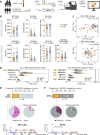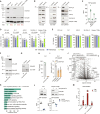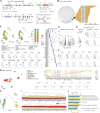A20 haploinsufficiency disturbs immune homeostasis and drives the transformation of lymphocytes with permissive antigen receptors
- PMID: 39167656
- PMCID: PMC11338232
- DOI: 10.1126/sciadv.adl3975
A20 haploinsufficiency disturbs immune homeostasis and drives the transformation of lymphocytes with permissive antigen receptors
Abstract
Genetic TNFAIP3 (A20) inactivation is a classical somatic lymphoma lesion and the genomic trait in haploinsufficiency of A20 (HA20). In a cohort of 34 patients with HA20, we show that heterozygous TNFAIP3 loss skews immune repertoires toward lymphocytes with classical self-reactive antigen receptors typically found in B and T cell lymphomas. This skewing was mediated by a feed-forward tumor necrosis factor (TNF)/A20/nuclear factor κB (NF-κB) loop that shaped pre-lymphoma transcriptome signatures in clonally expanded B (CD81, BACH2, and NEAT1) or T (GATA3, TOX, and PDCD1) cells. The skewing was reversed by anti-TNF treatment but could also progress to overt lymphoma. Analysis of conditional TNFAIP3 knock-out mice reproduced the wiring of the TNF/A20/NF-κB signaling axis with permissive antigen receptors and suggested a distinct regulation in B and T cells. Together, patients with the genetic disorder HA20 provide an exceptional window into A20/TNF/NF-κB-mediated control of immune homeostasis and early steps of lymphomagenesis that remain clinically unrecognized.
Figures






References
-
- Zhou Q., Wang H., Schwartz D. M., Stoffels M., Park Y. H., Zhang Y., Yang D., Demirkaya E., Takeuchi M., Tsai W. L., Lyons J. J., Yu X., Ouyang C., Chen C., Chin D. T., Zaal K., Chandrasekharappa S. C., Hanson E. P., Yu Z., Mullikin J. C., Hasni S. A., Wertz I. E., Ombrello A. K., Stone D. L., Hoffmann P., Jones A., Barham B. K., Leavis H. L., van Royen-Kerkof A., Sibley C., Batu E. D., Gul A., Siegel R. M., Boehm M., Milner J. D., Ozen S., Gadina M., Chae J., Laxer R. M., Kastner D. L., Aksentijevich I., Loss-of-function mutations in TNFAIP3 leading to A20 haploinsufficiency cause an early-onset autoinflammatory disease. Nat. Genet. 48, 67–73 (2016). - PMC - PubMed
-
- Hymowitz S. G., Wertz I. E., A20: From ubiquitin editing to tumour suppression. Nat. Rev. Cancer 10, 332–341 (2010). - PubMed
Publication types
MeSH terms
Substances
LinkOut - more resources
Full Text Sources

